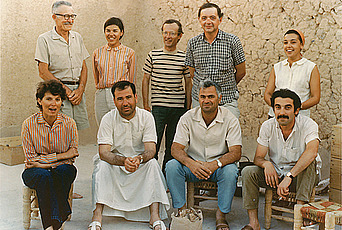The IAS Squeeze Collection: Origin and Development

Soon after his appointment as a Professor at the Institute, Benjamin Meritt took the first steps to build a Repository of Squeezes, “which will be second only to that in Berlin,” as he wrote to the Director, Abraham Flexner, on September 8, 1935. He intended to begin with the Epigraphical Museum in Athens and to have squeezes made of all its inscriptions, more than 13,000 at the time. He expected this to be done within a year for a sum of about $500. He also planned to establish a Working Library for Greek Epigraphy with an initial outlay of $2,000, plus $200 annually to keep it up-to-date. Before the end of the year, the Director had allocated the requested sums for both projects. Meritt went to work. From December onward, three men were working in the Epigraphical Museum making squeezes, a fourth on the Acropolis, and a fifth at Eleusis, a large community with a famous sanctuary, and a fortress. Furthermore, Meritt contacted several museums that had large holdings of Greek inscriptions; he wanted them to contribute to the squeeze collection: the Ashmolean, the British Museum, the Louvre, and the Archaeological Museum at Izmir.
Today, the total number of squeezes from the Epigraphical Museum amounts to 8,532 pieces in the IAS collection. It is rivaled only by those from the Athenian Agora. American excavations had begun there in 1931. Meritt was put in charge of dealing with the inscriptions, which soon ran into the thousands. Copies of their file cards, photographs, and squeezes, as well as Meritt’s transcriptions of their texts, came to the Institute, by August 1940 already amounting to six thousand. By August 1974, the number had risen to 7,184, of which the Institute has 7,135, plus 7,047 copies of their texts by Meritt. After Homer Thompson, another Institute Professor, retired as Field Director at the Agora and was replaced by Leslie Shear Jr. of Princeton University, the new materials went to Princeton University. After that, only a few dozen squeezes reached the Institute from the Agora, the one with the highest number in the inventory being 7,642.
Various scholars donated over time smaller parcels of squeezes. W. H. Buckler in 1936 gave 271, including 199 from Sardeis, with the rest coming from various places in Asia Minor. D. M. Robinson sent in October 1950 six boxes with squeezes from the Chalcidice and Asia Minor. In 1978, Charles Edson donated the notebooks from his expedition to Macedonia in the years 1936 to 1938, undertaken under contract with the Academy at Berlin for Inscriptiones Graecae. He also gave to the Institute copies of some eight hundred squeezes he had made during those years.
A major gift to the collection came in 1992 from Jeanne Robert, the widow of Louis Robert—some eight hundred squeezes the Roberts had made during their long careers, mainly in Asia Minor, but also in Greece and on the Greek islands, as well as large quantities from the Archaeological Museums at Istanbul, Izmir, and others, and even some Greek inscriptions from Bactria (for more on the Robert squeezes see www.hs.ias.edu/classics/squeezes). Even so, the bulk of their squeezes, no less than 3,497, remained in Paris, as part of the Fonds Louis Robert of the Académie des Inscriptions et Belles Lettres. In 1973, I gave eighty squeezes, mostly from Thessaly, some from Greece, and others from Asia Minor, to the collection. (I had given several hundred of my squeezes from Samos and Pergamon to the German Archaeological Institute.)
Other groups of squeezes are from inscriptions in the following museums: the Acropolis and National Museums at Athens, the Ashmolean Museum, including Chandler’s Marmora Oxoniensia, and the Archaeological Museum at Izmir.
Other groups are from various sites, in Athens: Theater of Dionysus, Roman Agora, South Slope, Temple of Hephaistos, Library of Hadrian, and Kerameikos; in Attica: Eleusis and Peiraieus; in Greece: Argos, Nauplia, Mycene, Corinth, Megara, Olympia, Oropos, Thessaly, Delphi, Maroneia, and Samothrace. A number of squeezes are also found in boxes labeled Asia Minor and SEG. Some major gaps still exist: inscriptions from the Athenian Agora with numbers higher than 7,184 and nearly all Attic inscriptions prior to 403 B.C. These are 1,517 pieces included in Inscriptiones Graecae I3, the squeezes of which Meritt bequeathed at his retirement to the University of Texas at Austin. The total of the Institute’s collection comes to some 25,000 squeezes and makes it in fact, “second only to that in Berlin.”


